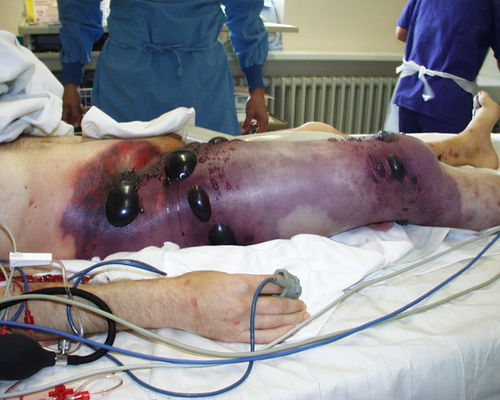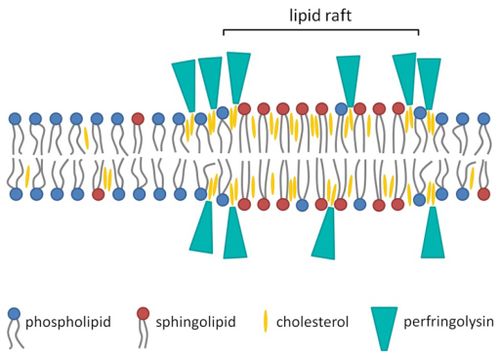The Role of Clostridium perfringens Toxins in Gas Gangrene: Difference between revisions
| Line 43: | Line 43: | ||
[http://casesjournal.biomedcentral.com/articles/10.1186/1757-1626-1-252 Schröpfer, Engelbert, Stephan Rauthe, and Thomas Meyer. "Diagnosis and Misdiagnosis of Necrotizing Soft Tissue Infections: Three Case Reports." Cases Journal 1.252 (2008): n. pag. BioMed Central. Web. 21 Apr. 2016.] | [http://casesjournal.biomedcentral.com/articles/10.1186/1757-1626-1-252 Schröpfer, Engelbert, Stephan Rauthe, and Thomas Meyer. "Diagnosis and Misdiagnosis of Necrotizing Soft Tissue Infections: Three Case Reports." Cases Journal 1.252 (2008): n. pag. BioMed Central. Web. 21 Apr. 2016.] | ||
[http://iai.asm.org/content/69/12/7904.full Awad, Milena M., Darren M. Ellemor, Richard L. Boyd, John J. Emmins, and Julian I. Rood. "Synergistic Effects of Alpha-Toxin and Perfringolysin O in Clostridium Perfringens-Mediated Gas Gangrene." Infection and Immunity 69.12 (2001): 7904-910. American Society for Microbiology. Web. 18 Apr. 2016.] | |||
Revision as of 03:58, 22 April 2016
What is Gas Gangrene?
By Marysol Arce

Clostridium perfringens is a gram positive and rod shaped bacterium. It lives in anaerobic environments like the soil and inside the gut of humans and animals. There are five different strains of Clostridium perfringens: A, B, C, D, and E. The A strain is of the most importance because it causes gas gangrene, or myonecrosis, in humans. Gangrene is the death of body tissue and usually seen in elderly people or diabetic people. Open wounds that become infected by bacteria also become gangrenous. Gas gangrene is an especially dangerous form because it spreads quickly throughout the body if left untreated, and can be fatal. C. perfringens produces toxins that kills cells and releases gas, leaving parts of the body black, purple, and covered with blisters.
The A strain C. perfringens produces two toxins that enable the spread of the bacterium and tissue death: the alpha toxin and perfringolysin O. The alpha toxin, also known as CPA or PLC, is a crucial virulence factor for this bacterium because it cannot cause gas gangrene without it. The alpha toxin and perfringolysin O (PFO) work synergistically to accomplish the spread of infection (Awad et al. 2001).
Other examples:
Bold
Italic
Subscript: H2O
Superscript: Fe3+
Introduce the topic of your paper. What is your research question? What experiments have addressed your question? Applications for medicine and/or environment?
A citation code consists of a hyperlinked reference within "ref" begin and end codes.
[1]
Alpha Toxin (PLC)
Include some current research, with at least one figure showing data.
Every point of information REQUIRES CITATION using the citation tool shown above.
All strains of C. perfringens produce the alpha toxin, also called CPA or PLC. The alpha toxin cleaves molecules from the surface the host cell's’ phospholipid bilayers and disrupts the membrane’s functions, which then promotes cell lysis and death.
Perfringolysin O (PFO)
Include some current research, with at least one figure showing data.
All strains of C. perfringens can produce the toxin perfringolysin O (PFO). This toxin is part of a pore-forming toxin family, the cholesterol-dependent cytolysin (CDC) family. PFO oligomerizes at the host cell’s surface to form a pore complex and then inserts itself into the cell membrane to form a large pore. The formation of this large pore disrupts the cell membrane, which causes cell lysis. But has been thought that cell lysis is not the main biological effect of this toxin on infected tissue. PFO, as well as CPA, prevent white blood cell influx at the site of infection. Because the body’s immune system is not able to fight the infection, this toxin aids in the decay of flesh and tissue. Although the alpha toxin is critical to the virulence, PFO is not. Although it may not be essential, it is synergistic with CPA. Both act together and boost the effect of the disease to speed up necrosis.

Section 3
Include some current research, with at least one figure showing data.
